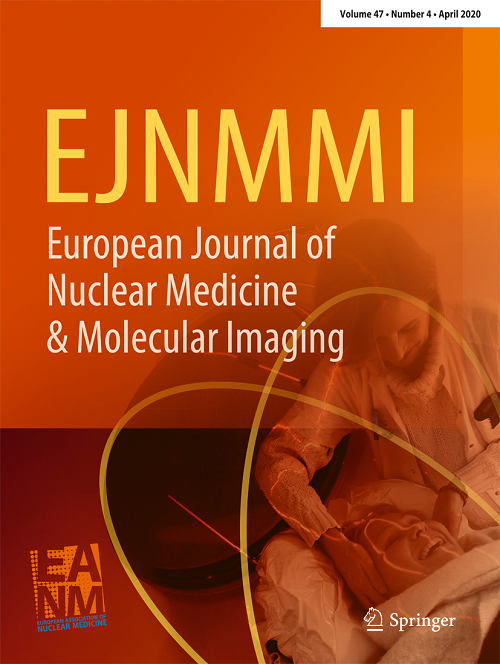AIMN, ITANET, SIE joint position paper for the recognition, prevention and management of NET carcinoid syndrome and crises during peptide receptor radionuclide therapy.
IF 7.6
1区 医学
Q1 RADIOLOGY, NUCLEAR MEDICINE & MEDICAL IMAGING
European Journal of Nuclear Medicine and Molecular Imaging
Pub Date : 2025-10-07
DOI:10.1007/s00259-025-07596-2
引用次数: 0
Abstract
PURPOSE Carcinoid syndrome (CS) is the most frequent neuroendocrine tumor (NET)-related syndrome with variable presentations related to hormonal discharge and long-term complications, such as carcinoid heart disease (CHD). Carcinoid crisis (CC) is an acute and serious CS complication, due to a massive release of vasoactive hormones and biologically active substances, which may occur during stressogenic procedures such as peptide receptor radionuclide therapy (PRRT). CC is an emergency and life-threatening condition that needs to be prevented, promptly recognized, and managed. The purpose of this joint Italian multidisciplinary position paper is to support the involved personnel in delivering [177Lu]Lu-based PRRT to syndromic NET patients, focusing on CC management. METHODS The literature evidence regarding CS, CHD, and CC during/after PRRT and the knowledge of 22 Italian NET experts in Anesthesiology, Endocrinology, Gastroenterology, Nuclear Medicine, Oncology, and Surgery involved in PRRT were the basis for the present document. RESULTS The expert panel expressed several recommendations regarding: 1) CC high-risk patients identification; 2) CC prevention, including considerations of the behavioral and nutritional status, and somatostatin analogue therapy; 3) how to implement PRRT premedication in CC high-risk patients; 4) how to manage CC during PRRT, including post-PRRT monitoring, and radiation protection considerations. CONCLUSION This practical guide summarizes the views and experience in CS, CHD, and CC in relation to PRRT of a joint NET-dedicated Italian multidisciplinary team. These recommendations should be taken into the context of Nuclear Medicine good practice and do not substitute any national and International legal or regulatory provisions.AIMN, ITANET, SIE关于肽受体放射性核素治疗中NET类癌综合征和危象的识别、预防和管理的联合立场文件。
类癌综合征(CS)是最常见的神经内分泌肿瘤(NET)相关综合征,其表现多样,与激素排放和长期并发症有关,如类癌心脏病(CHD)。类癌危机(CC)是一种急性和严重的CS并发症,由于在应激源性手术(如肽受体放射性核素治疗(PRRT))中可能发生血管活性激素和生物活性物质的大量释放。CC是一种紧急和危及生命的疾病,需要预防、及时识别和管理。这份意大利联合多学科立场文件的目的是支持相关人员向综合征性NET患者提供[177Lu] lu为基础的PRRT,重点是CC管理。方法以22名意大利麻醉学、内分泌学、胃肠病学、核医学、肿瘤学和外科专家在PRRT期间/之后的CS、CHD和CC相关文献为基础。结果专家组提出了以下几点建议:1)鉴别CC高危患者;2) CC预防,包括考虑行为和营养状况,以及生长抑素类似物治疗;3)如何在CC高危患者中实施PRRT预用药;4) PRRT期间如何管理CC,包括PRRT后的监测和辐射防护考虑。结论:本实用指南总结了意大利联合net多学科团队在CS、CHD和CC与PRRT相关的观点和经验。这些建议应纳入核医学良好做法的范畴,不能取代任何国家和国际法律或监管规定。
本文章由计算机程序翻译,如有差异,请以英文原文为准。
求助全文
约1分钟内获得全文
求助全文
来源期刊
CiteScore
15.60
自引率
9.90%
发文量
392
审稿时长
3 months
期刊介绍:
The European Journal of Nuclear Medicine and Molecular Imaging serves as a platform for the exchange of clinical and scientific information within nuclear medicine and related professions. It welcomes international submissions from professionals involved in the functional, metabolic, and molecular investigation of diseases. The journal's coverage spans physics, dosimetry, radiation biology, radiochemistry, and pharmacy, providing high-quality peer review by experts in the field. Known for highly cited and downloaded articles, it ensures global visibility for research work and is part of the EJNMMI journal family.

 求助内容:
求助内容: 应助结果提醒方式:
应助结果提醒方式:


